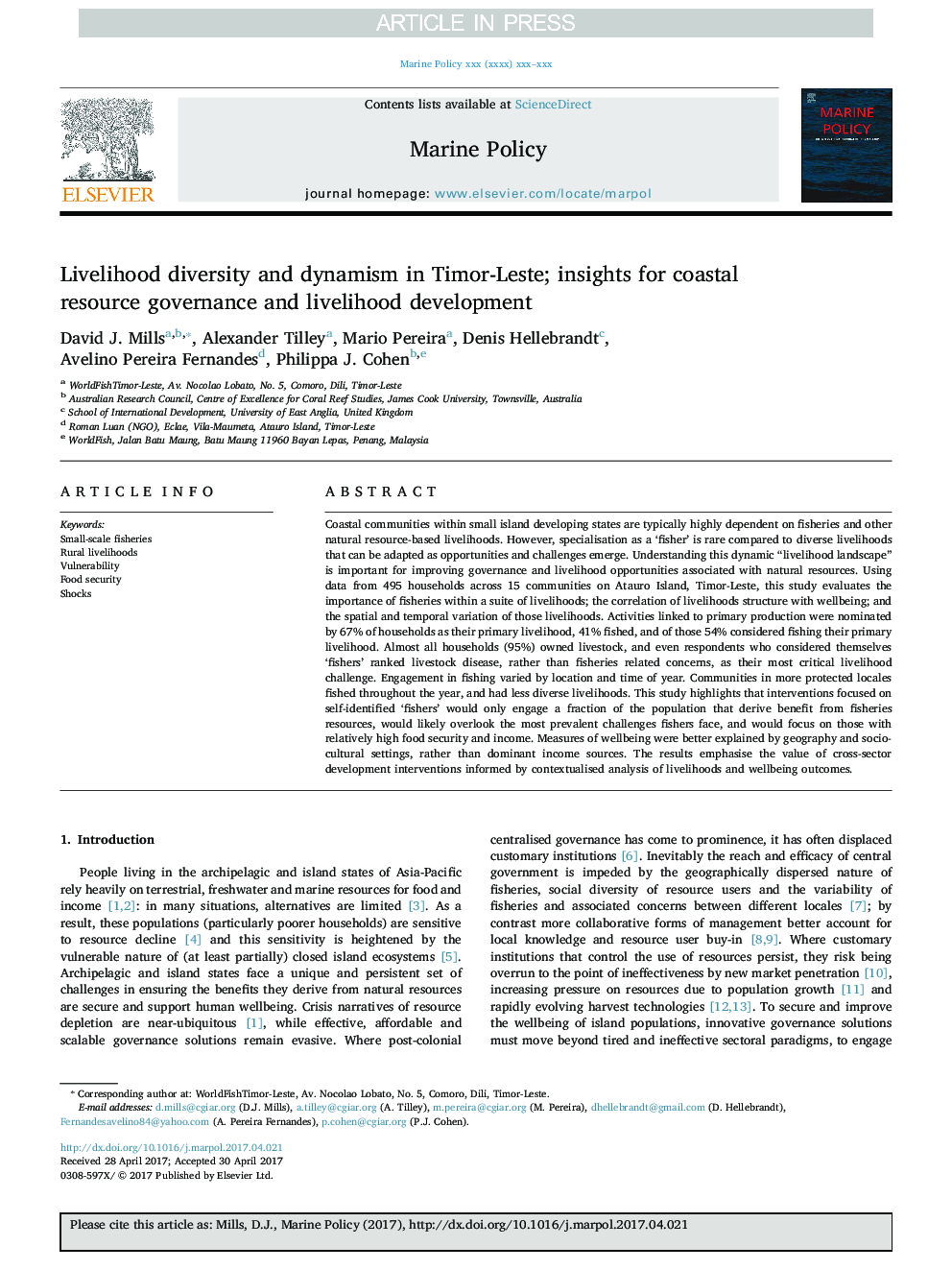| کد مقاله | کد نشریه | سال انتشار | مقاله انگلیسی | نسخه تمام متن |
|---|---|---|---|---|
| 5118277 | 1485497 | 2017 | 10 صفحه PDF | دانلود رایگان |
عنوان انگلیسی مقاله ISI
Livelihood diversity and dynamism in Timor-Leste; insights for coastal resource governance and livelihood development
ترجمه فارسی عنوان
تنوع و پویش معیشت در تیمور-لست؛ بینش برای مدیریت منابع ساحلی و توسعه معیشت
دانلود مقاله + سفارش ترجمه
دانلود مقاله ISI انگلیسی
رایگان برای ایرانیان
کلمات کلیدی
ماهیگیری کوچک معیشت روستایی، آسیب پذیری، امنیت غذایی، شوک،
ترجمه چکیده
جوامع ساحلی در کشورهای در حال توسعه جزیره کوچک به طور عمده وابسته به شیلات و دیگر منابع معیشت منابع طبیعی هستند. با این حال، تخصص به عنوان یک "فیشر" در مقایسه با معیشت های گوناگون نادر است که می تواند به عنوان فرصت ها و چالش ها مطابقت داشته باشد. درک این پویا و چشم انداز معیشت؟ برای بهبود حاکمیت و فرصت های معیشت مرتبط با منابع طبیعی مهم است. با استفاده از داده ها از 495 خانوار در 15 جوامع در جزیره آتاورو، تیمور لست، این مطالعه اهمیت ماهیگیری در مجموعه معیشت را ارزیابی می کند؛ همبستگی ساختار معیشت با سلامتی؛ و تنوع فضایی و زمانی آن معیشت. فعالیت های مرتبط با تولید اولیه 67 درصد خانوارها به عنوان معیشت اولیه خود، 41 درصد ماهیگیری، و 54 درصد آن ماهیانه معیشت اولیه خود را ماهیانه نامگذاری کردند. تقریبا تمام خانوارها (95٪) دامداری داشتند و حتی پاسخ دهندگان که خودشان "ماهیگیران" را به عنوان حیوانات حیاتی ترین چالش در معرض حیات دامداران خود قرار داده اند، به جای نگرانی های مربوط به شیلات. تعامل در ماهیگیری با مکان و زمان سال متفاوت است. جوامع در مناطق محافظت شده بیشتر در طول سال خوراک داشتند و منابع معیشتی کمتری داشتند. این مطالعه نشان می دهد که مداخلات متمرکز بر "ماهیگیران" خود شناخته شده تنها بخش کوچکی از جمعیت را که از منابع شیلات بهره مند می شوند، در نظر می گیرند، احتمالا شایع ترین چالش های ماهیگیران را نادیده می گیرند و بر افراد با امنیت غذایی و درآمد نسبتا بالا تمرکز می کنند . معیارهای سلامتی بهتر از جغرافیای و تنظیمات اجتماعی و فرهنگی، به جای منابع درآمد غالب، توضیح داده شده است. نتایج بر ارزش مداخلات توسعه بخش های مختلف بر اساس تجزیه و تحلیل محتوا از معیشت و نتایج به دست آمده تاکید می کنند.
موضوعات مرتبط
مهندسی و علوم پایه
سایر رشته های مهندسی
مهندسی دریا (اقیانوس)
چکیده انگلیسی
Coastal communities within small island developing states are typically highly dependent on fisheries and other natural resource-based livelihoods. However, specialisation as a 'fisher' is rare compared to diverse livelihoods that can be adapted as opportunities and challenges emerge. Understanding this dynamic “livelihood landscape” is important for improving governance and livelihood opportunities associated with natural resources. Using data from 495 households across 15 communities on Atauro Island, Timor-Leste, this study evaluates the importance of fisheries within a suite of livelihoods; the correlation of livelihoods structure with wellbeing; and the spatial and temporal variation of those livelihoods. Activities linked to primary production were nominated by 67% of households as their primary livelihood, 41% fished, and of those 54% considered fishing their primary livelihood. Almost all households (95%) owned livestock, and even respondents who considered themselves 'fishers' ranked livestock disease, rather than fisheries related concerns, as their most critical livelihood challenge. Engagement in fishing varied by location and time of year. Communities in more protected locales fished throughout the year, and had less diverse livelihoods. This study highlights that interventions focused on self-identified 'fishers' would only engage a fraction of the population that derive benefit from fisheries resources, would likely overlook the most prevalent challenges fishers face, and would focus on those with relatively high food security and income. Measures of wellbeing were better explained by geography and socio-cultural settings, rather than dominant income sources. The results emphasise the value of cross-sector development interventions informed by contextualised analysis of livelihoods and wellbeing outcomes.
ناشر
Database: Elsevier - ScienceDirect (ساینس دایرکت)
Journal: Marine Policy - Volume 82, August 2017, Pages 206-215
Journal: Marine Policy - Volume 82, August 2017, Pages 206-215
نویسندگان
David J. Mills, Alexander Tilley, Mario Pereira, Denis Hellebrandt, Avelino Pereira Fernandes, Philippa J. Cohen,
